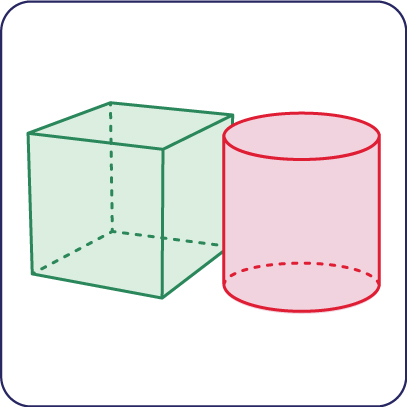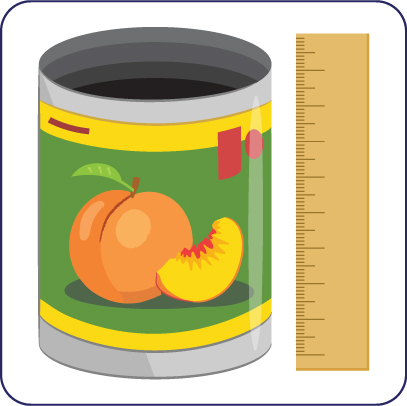Minds On
Three-dimensional nets
For each 3D Shape, select the corresponding net.
For each 3D Shape, select the corresponding net.
Brainstorm
Reflect
Let's take a moment to reflect on the following question:
How can the nets of prisms and cylinders help us to solve problems related to the surface area and volume of these three-dimensional shapes?
Action
Surface area and nets
Surface area is the total area of the surface of a three-dimensional object.
To determine the surface area, it is helpful to consider the net of the object.
Nets help us to investigate the two-dimensional shapes that make up a three-dimensional object.

Surface area of a prism
To find the total surface area of a prism, explore the following steps:
- First, calculate the area of the top face and the bottom face (base). In a prism, the top face and the base are congruent.
- Next, calculate the area of the side faces connecting the top face and the base.
- Then, add up the area of all the faces to determine the total surface area of a prism.
Let's calculate!
Examine the following rectangular prism.

The diagram includes a three-dimensional object and a two-dimensional shape that makes up the three-dimensional object. A rectangular prism with a length of 3 centimetres, a width of 2 centimetres, and a height of 6 centimetres. The net of the prism includes 6 rectangles. There are 3 pairs of congruent rectangles. The first pair has two rectangles that are 3 centimetres by 2 centimetres. Another pair has two rectangles that are 6 centimetres by 2 centimetres. And the last pair has two rectangles that are 3 centimetres by 6 centimetres.
Let's calculate the surface area:
- What is the formula for calculating the area of each of the faces of this prism?
- What is the area of the top face?
- What is the area of the bottom face (base)?
- How many side faces are there? What is the area of the side faces?
- What is the total surface area of this prism?
If you would like, you can complete the activity using TVO Mathify or a method of your choice. You can also use your notebook or the following fillable and printable document.
Press the ‘TVO Mathify' button to access this interactive whiteboard and the ‘Activity’ button for your note-taking document. You will need a TVO Mathify login to access this resource.
TVO Mathify (Opens in a new window) Activity (Open PDF in a new window)Press ‘Let's check!’ to reveal the calculations for the Surface Area: Rectangular Prism activity.
Since each face of the rectangular prism is a rectangle, use the formula A = l × w
to calculate the area of each face.
Area of top face: 3 × 2 = 6 cm2
Area of face: 3 × 2 = 6 cm2
There are four side faces. There are two pairs that are congruent.
Area of Side 1: 6 × 2 = 12 cm2
Area of Side 2: 6 × 2 = 12 cm2
Area of Side 3: 6 × 3 = 18 cm2
Area of Side 4: 6 × 3 = 18 cm2
The total surface area = 6 + 6 + 12 + 12 + 18 + 18 = 72
Therefore, the total surface area is 72 cm2
Surface area of a cylinder
Examine the following cylinder. You can use a net to calculate its surface area.
Let's explore the cylinder together! Your teacher will show you how to use the 3D shape and then you can try using it yourself!
Press 'Let's check!' to reveal the surface area of the cylinder.
The surface area of cylinder = π(4)² + π(4)² + 2π(4)(15) = 477.52 cm².
Student Tips
Did you know?
The circumference of the circle (2πr ) is one side length of the rectangle and the other side length is the height of the cylinder.
Exploring the cylinder
Let’s explore the following cylinder and how to calculate the surface area:

The diagram includes a three-dimensional soup can and a two-dimensional shape that makes up the three-dimensional soup can. The three-dimensional can of soup has a vertical dotted line running through the middle, which is labelled “h” for height. The two-dimensional image is a net of the cylinder. In the net diagram, there are two circles on the top and bottom of the rectangle. The circles can be calculated by the circumference, with two times pi times radius. A rectangle, representing the label of the can in two dimensions, is located between the two circles. The length of the rectangle can be calculated by two times pi times the radius. The height of soup can is the same as the width of a rectangle.
Therefore, the surface area of a cylinder is equal to:
Area of top circle Area of bottom circle Area of rectangle
Volume
Volume is the amount of space occupied by an object.
Volume of a prism
The volume of any prism is:
Volume = (area of the base) = height
If you would like, you can complete the next activity using TVO Mathify or a method of your choice. You can also use your notebook or the following fillable and printable document.

Press the ‘TVO Mathify' button to access this interactive whiteboard and the ‘Activity’ button for your note-taking document. You will need a TVO Mathify login to access this resource.
TVO Mathify (Opens in a new window) Activity (Open PDF in a new window)Press 'Let's check!' to reveal the calculations for the 'Volume of a Prism' activity.
Volume = (area of the triangular base) × height
Volume =
Volume = 1,848 m3
Volume of a cylinder
If the volume of a cylinder can be calculated in the same way as the volume of other prisms, what is your prediction for the formula?
Student Tips
What do you think?
The volume of a cylinder is more specific than the volume of a prism:
Volume = (area of the base) height
Press 'Let's check!' to reveal the volume formula for a cylinder.
Consider the formula for the volume of a cylinder as being the area of the base, or the circle (A = π r2) multiplied by the height, where is the radius, and represents the height.

Let's calculate!
If you would like, you can complete the next activity using TVO Mathify or a method of your choice. You can also use your notebook or the following fillable and printable document.

Press the ‘TVO Mathify' button to access this interactive whiteboard and the ‘Activity’ button for your note-taking document. You will need a TVO Mathify login to access this resource.
TVO Mathify (Opens in a new window) Activity (Open PDF in a new window)Press ‘Let's check!’ to reveal calculations for the Volume of a Cylinder Activity.
Consolidation
Surface area and volume of real world cylinders

If you would like, you can complete the next activity using TVO Mathify or a method of your choice. You can also use your notebook or the following fillable and printable document.

Press the ‘TVO Mathify' button to access this interactive whiteboard and the ‘Activity’ button for your note-taking document. You will need a TVO Mathify login to access this resource.
TVO Mathify (Opens in a new window) Activity (Open PDF in a new window)Let's explore the cylinder together! Your teacher will show you how to use the 3D shape and then you can try using it yourself!
Press ‘Let’s check!’ to reveal the calculations for the Surface Area and Volume of a Cylinder activity.
Since the can only has one circular base, the surface area of the cylinder is:
The volume isn't affected by the removal of the lid.
Reflection
As you read the following descriptions, select the one that best describes your current understanding of the learning in this activity. Press the corresponding button once you have made your choice.
I feel...
Now, expand on your ideas by recording your thoughts using a voice recorder, speech-to-text, or writing tool.
When you review your notes on this learning activity later, reflect on whether you would select a different description based on your further review of the material in this learning activity.
Connect with a TVO Mathify tutor
Think of TVO Mathify as your own personalized math coach, here to support your learning at home. Press ‘TVO Mathify’ to connect with an Ontario Certified Teacher math tutor of your choice. You will need a TVO Mathify login to access this resource.
TVO Mathify (Opens in a new window)